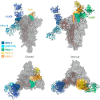This is a preprint.
Memory B cell repertoire for recognition of evolving SARS-CoV-2 spike
- PMID: 33758863
- PMCID: PMC7987022
- DOI: 10.1101/2021.03.10.434840
Memory B cell repertoire for recognition of evolving SARS-CoV-2 spike
Update in
-
Memory B cell repertoire for recognition of evolving SARS-CoV-2 spike.Cell. 2021 Sep 16;184(19):4969-4980.e15. doi: 10.1016/j.cell.2021.07.025. Epub 2021 Jul 23. Cell. 2021. PMID: 34332650 Free PMC article.
Abstract
Memory B cell reserves can generate protective antibodies against repeated SARS-CoV-2 infections, but with an unknown reach from original infection to antigenically drifted variants. We charted memory B cell receptor-encoded monoclonal antibodies (mAbs) from 19 COVID-19 convalescent subjects against SARS-CoV-2 spike (S) and found 7 major mAb competition groups against epitopes recurrently targeted across individuals. Inclusion of published and newly determined structures of mAb-S complexes identified corresponding epitopic regions. Group assignment correlated with cross-CoV-reactivity breadth, neutralization potency, and convergent antibody signatures. mAbs that competed for binding the original S isolate bound differentially to S variants, suggesting the protective importance of otherwise-redundant recognition. The results furnish a global atlas of the S-specific memory B cell repertoire and illustrate properties conferring robustness against emerging SARS-CoV-2 variants.
Conflict of interest statement
Competing interests The authors declare no competing interests.
Figures





Similar articles
-
Memory B cell repertoire for recognition of evolving SARS-CoV-2 spike.Cell. 2021 Sep 16;184(19):4969-4980.e15. doi: 10.1016/j.cell.2021.07.025. Epub 2021 Jul 23. Cell. 2021. PMID: 34332650 Free PMC article.
-
Monoclonal antibodies constructed from COVID-19 convalescent memory B cells exhibit potent binding activity to MERS-CoV spike S2 subunit and other human coronaviruses.Front Immunol. 2022 Dec 22;13:1056272. doi: 10.3389/fimmu.2022.1056272. eCollection 2022. Front Immunol. 2022. PMID: 36618428 Free PMC article.
-
Cross-Neutralization of Emerging SARS-CoV-2 Variants of Concern by Antibodies Targeting Distinct Epitopes on Spike.mBio. 2021 Dec 21;12(6):e0297521. doi: 10.1128/mBio.02975-21. Epub 2021 Nov 16. mBio. 2021. PMID: 34781736 Free PMC article. Clinical Trial.
-
A Combination of Receptor-Binding Domain and N-Terminal Domain Neutralizing Antibodies Limits the Generation of SARS-CoV-2 Spike Neutralization-Escape Mutants.mBio. 2021 Oct 26;12(5):e0247321. doi: 10.1128/mBio.02473-21. Epub 2021 Oct 5. mBio. 2021. PMID: 34607456 Free PMC article.
-
Susceptibility of SARS-CoV-2 Omicron Variants to Therapeutic Monoclonal Antibodies: Systematic Review and Meta-analysis.Microbiol Spectr. 2022 Aug 31;10(4):e0092622. doi: 10.1128/spectrum.00926-22. Epub 2022 Jun 14. Microbiol Spectr. 2022. PMID: 35700134 Free PMC article.
Cited by
-
EGF receptor in organ development, tissue homeostasis and regeneration.J Biomed Sci. 2025 Feb 19;32(1):24. doi: 10.1186/s12929-025-01119-9. J Biomed Sci. 2025. PMID: 39966897 Free PMC article. Review.
References
-
- Victora G. D., Nussenzweig M. C., Germinal centers. Annu Rev Immunol 30, 429–457 (2012). - PubMed
Publication types
Grants and funding
LinkOut - more resources
Full Text Sources
Other Literature Sources
Miscellaneous
